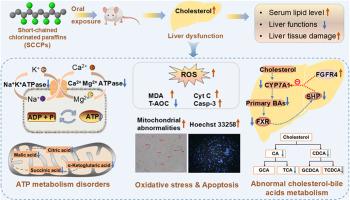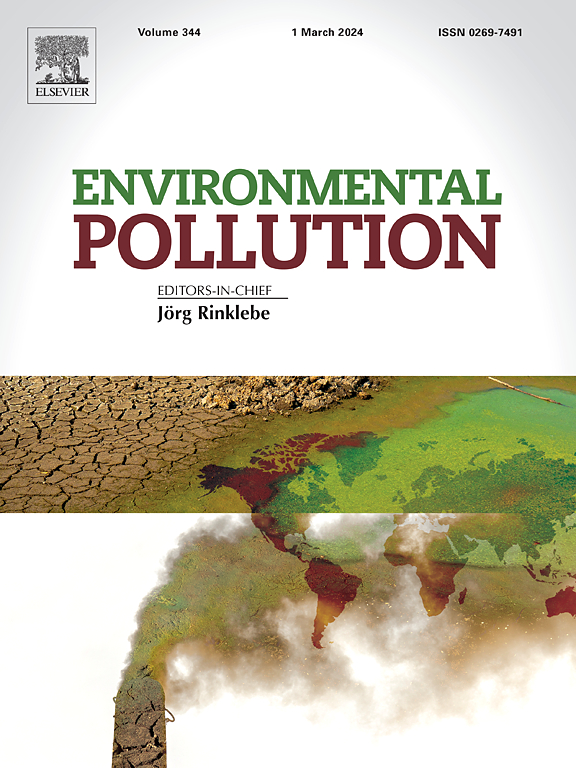短链氯化石蜡通过线粒体紊乱和胆固醇-胆汁酸途径的破坏诱发小鼠肝损伤
IF 7.6
2区 环境科学与生态学
Q1 ENVIRONMENTAL SCIENCES
引用次数: 0
摘要
短链氯化石蜡(SCCPs)是一种普遍存在的有机污染物,具有持久性和生物毒性。本研究调查了短链氯化石蜡在环境相关浓度(0.7 μg/kg)下的肝脏毒性机制。结果表明,小鼠接触短链氯化石蜡会导致血液和肝脏脂质失调,表现为胆固醇水平升高。此外,肝功能也受到损害,表现为天门冬氨酸氨基转移酶、丙氨酸氨基转移酶和碱性磷酸酶水平升高。接触短链氯化石蜡后,肝组织的组织病理学检查显示肝细胞增大、空泡变性和轻度气球变性。从机理上讲,短链氯化石蜡诱导线粒体异常,表现为 Hoechst 33258 荧光增强,肝组织中的活性氧和丙二醛水平升高。与此同时,总抗氧化能力下降,最终导致细胞色素 C 和 caspase-3 等细胞凋亡标志物升高。此外,短链氯化石蜡扰乱了肝细胞的能量代谢,表现为糖酵解、乳酸和脂肪酸氧化增加,三羧酸循环紊乱,线粒体能量代谢功能下降。此外,接触短链氯化石蜡还会下调参与胆汁酸合成的基因(cyp27a1、fxr 和 shp)的表达,从而导致胆固醇-胆汁酸代谢紊乱和胆固醇积累。总之,这些发现强调了短链氯化石蜡即使在环境相关水平下也能诱发肝细胞中的脂质失调、线粒体紊乱和胆固醇沉积,从而导致肝损伤。这项研究的见解有助于人们理解短链氯化石蜡诱导的肝毒性,并可能为与短链氯化石蜡暴露相关的肝损伤提供潜在的预防和治疗目标。本文章由计算机程序翻译,如有差异,请以英文原文为准。

Short-chain chlorinated paraffins induce liver injury in mice through mitochondrial disorders and disruption of cholesterol-bile acid pathway
Short-chain chlorinated paraffins (SCCPs) are pervasive organic pollutants recognized for their persistence and bio-toxicity. This study investigated the hepatotoxic mechanisms of SCCPs at environmentally relevant concentration (0.7 μg/kg). The results showed that SCCPs exposure in mice resulted in dysregulated blood and liver lipids, marked by elevated cholesterol levels. Additionally, liver function was compromised, as indicated by increased levels of aspartate aminotransferase, alanine aminotransferase, and alkaline phosphatase. Histopathological examination of liver tissue post-SCCPs exposure revealed hepatocyte enlargement, vacuolar degeneration, and mild ballooning degeneration. Mechanistically, SCCPs induced mitochondrial abnormalities, evidenced by heightened Hoechst 33258 fluorescence, and augmented reactive oxygen species and malondialdehyde levels in liver tissue. This was accompanied by a reduction in total antioxidant capacity, culminating in elevated apoptosis markers, including cytochrome C and caspase-3. Moreover, SCCPs perturbed hepatocellular energy metabolism, characterized by increased glycolysis, lactic acid, and fatty acid oxidation, alongside a disruption in the tricarboxylic acid cycle and a decline in mitochondrial energy metabolic function. Furthermore, SCCPs exposure downregulated the expression of genes involved in bile acid synthesis (cyp27a1, fxr, and shp), thereby precipitating the cholesterol-bile acid metabolism disorders and cholesterol accumulation. Collectively, these findings underscore that SCCPs, even at environmentally relevant levels, can induce lipid dysregulation, mitochondrial disorders and cholesterol deposition in the hepatocytes, contributing to liver damage. The study’s insights contribute to a comprehension of SCCPs-induced hepatotoxicity and may inform potential preventative and treatment targets for hepatic damage associated with SCCPs exposure.
求助全文
通过发布文献求助,成功后即可免费获取论文全文。
去求助
来源期刊

Environmental Pollution
环境科学-环境科学
CiteScore
16.00
自引率
6.70%
发文量
2082
审稿时长
2.9 months
期刊介绍:
Environmental Pollution is an international peer-reviewed journal that publishes high-quality research papers and review articles covering all aspects of environmental pollution and its impacts on ecosystems and human health.
Subject areas include, but are not limited to:
• Sources and occurrences of pollutants that are clearly defined and measured in environmental compartments, food and food-related items, and human bodies;
• Interlinks between contaminant exposure and biological, ecological, and human health effects, including those of climate change;
• Contaminants of emerging concerns (including but not limited to antibiotic resistant microorganisms or genes, microplastics/nanoplastics, electronic wastes, light, and noise) and/or their biological, ecological, or human health effects;
• Laboratory and field studies on the remediation/mitigation of environmental pollution via new techniques and with clear links to biological, ecological, or human health effects;
• Modeling of pollution processes, patterns, or trends that is of clear environmental and/or human health interest;
• New techniques that measure and examine environmental occurrences, transport, behavior, and effects of pollutants within the environment or the laboratory, provided that they can be clearly used to address problems within regional or global environmental compartments.
 求助内容:
求助内容: 应助结果提醒方式:
应助结果提醒方式:


